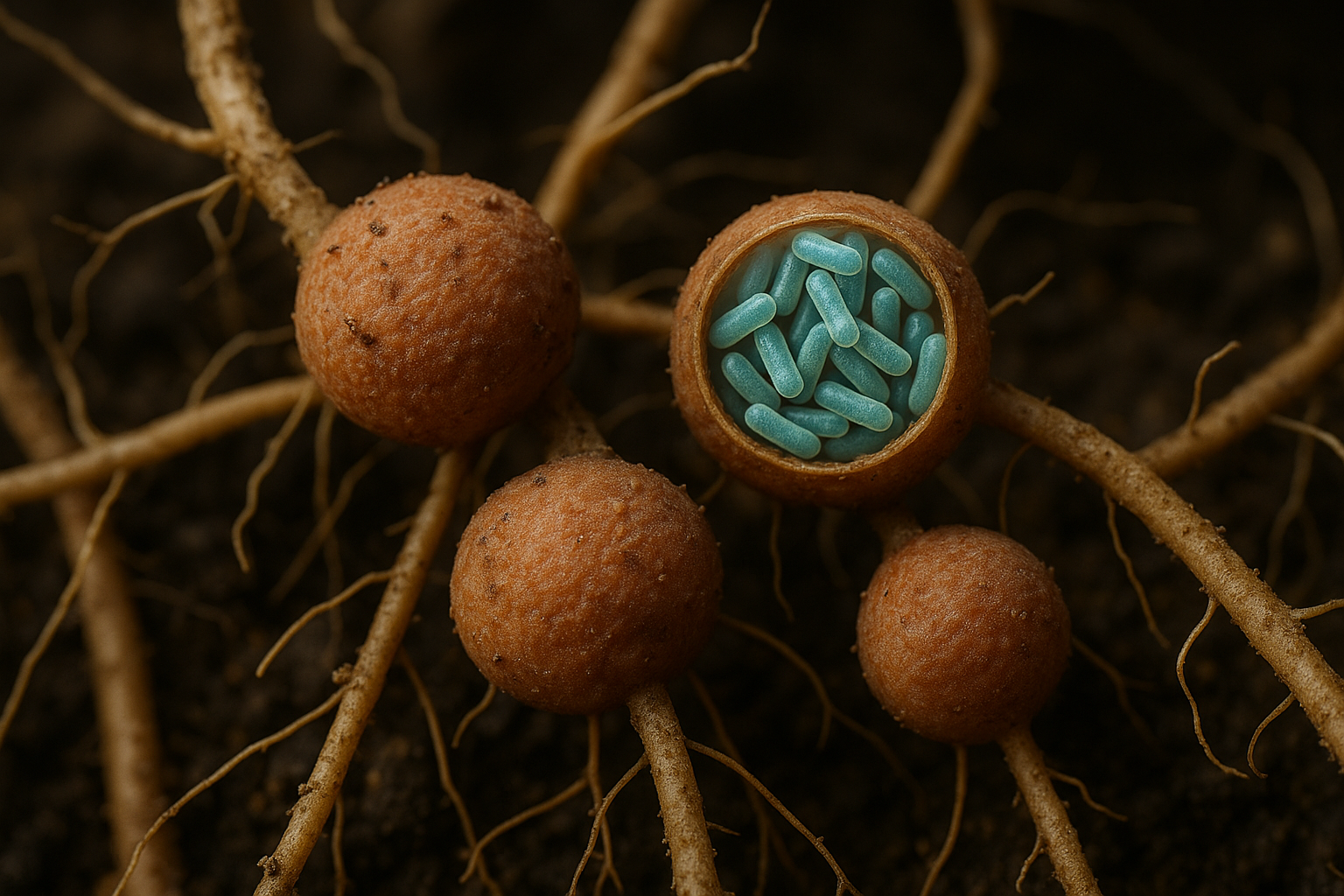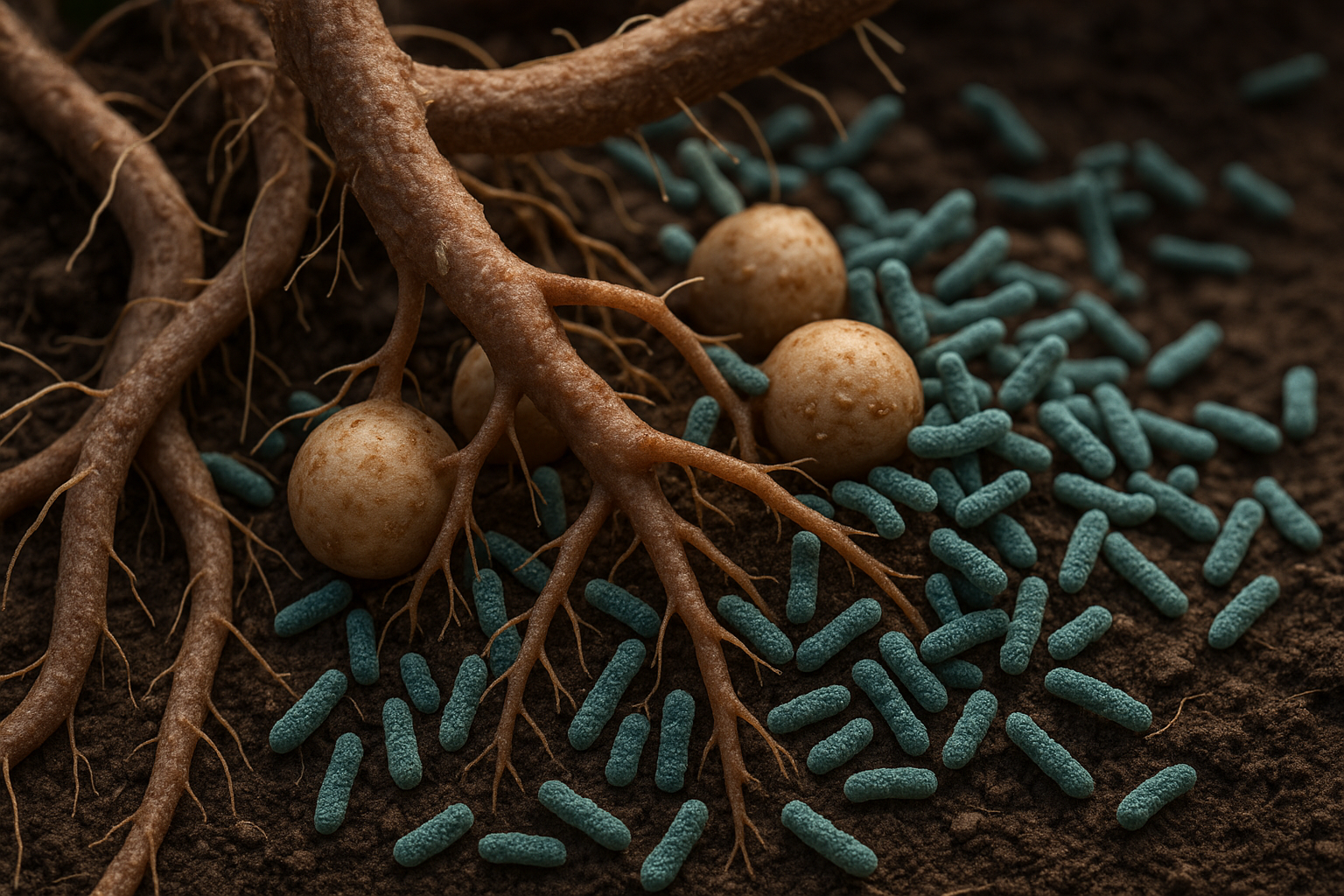Our world’s soil teems with unseen partners that quietly nourish plants without any help from fertilizers. In back yards and sprawling fields, these microbes capture nitrogen from air and hand it over to roots. Without them, legumes would wither and ecosystems would collapse. This article explores who these bacterial allies are and why they matter, especially as we try to reduce our reliance on synthetic fertilizers.
Nitrogen is one of the building blocks of proteins and DNA, yet the nitrogen that makes up roughly 80 percent of the air is almost unusable to most organisms. To make use of it, the strong triple bond in nitrogen gas has to be broken and converted to ammonia. Industrially this is done by the Haber‑Bosch process, which runs at high temperatures and pressures and consumes about two percent of the world’s energy while generating substantial greenhouse gas emissions. Biological nitrogen fixation offers a gentler alternative: certain bacteria convert atmospheric nitrogen into a form plants can use, working at room temperature and pressure.

Why Nitrogen Fixation Matters
Synthetic nitrogen fertilizers have helped feed billions of people, but making them carries a high environmental cost. The Haber–Bosch process relies on fossil fuels; producing ammonia for agriculture accounts for roughly two percent of global energy consumption and releases large volumes of carbon dioxide and nitrous oxide. In the fields, much of the nitrogen applied never reaches crops; studies show that around a quarter of fertilizer nitrogen leaches into waterways or volatilizes into the atmosphere, contributing to smog and dead zones. Countries are searching for ways to cut these losses while maintaining yields, and more farmers are turning to biological sources of nitrogen to do that.
How Nitrogen‑Fixing Bacteria Work
Nitrogen fixation is carried out by enzymes collectively known as nitrogenase. Breaking the triple bond in N₂ is energetically demanding, and bacteria must invest at least 16 molecules of ATP for every molecule of nitrogen gas they convert to ammonia, with additional ATP required to assimilate the ammonia into amino acids. The proteins involved are extremely sensitive to oxygen; even brief exposure can inactivate them. Diazotrophs have evolved strategies to protect nitrogenase, such as thick cell walls, specialized slime layers, or proteins like FeSII that bind oxygen when concentrations rise and release it when levels drop again. Many fixers only operate under low‑oxygen conditions or at night when respiration has depleted oxygen around them.
Kinds of Nitrogen‑Fixing Bacteria
Scientists classify nitrogen‑fixing bacteria into three broad groups. Free‑living diazotrophs are independent organisms that fix nitrogen in soil or water without direct association with plants. Associative bacteria live on or around roots and exchange nutrients with their hosts, but they do not form specialized organs. Symbiotic bacteria form the most intimate relationships: they trigger the growth of root nodules where the bacteria, now called bacteroids, live inside plant cells and exchange fixed nitrogen for carbohydrates. Symbioses with legumes are particularly efficient, supplying an estimated 20–300 kilograms of nitrogen per hectare each year, whereas free‑living and associative fixers collectively provide roughly 30 percent of the total biological nitrogen fixed on land. Even maize varieties cultivated by Indigenous communities in Mexico obtain up to 82 percent of their nitrogen from mucilage‑dwelling bacteria that surround their aerial roots, highlighting the diversity of these partnerships.
Free‑Living and Associative Fixers
One of the best‑known free‑living fixers is Azotobacter, a genus of Gram‑negative bacteria discovered by the Dutch microbiologist Martinus Beijerinck in the late nineteenth century. These soil microbes move using flagella and can form thick‑walled cysts that allow them to survive in harsh conditions such as desiccation or nutrient deprivation. Azotobacter secretes substances that stimulate other beneficial microbes in the rhizosphere and produces hormones like indole acetic acid and gibberellin that encourage root growth. On croplands, inoculants containing Azotobacter can fix around 20 kilograms of nitrogen per hectare annually and have been reported to reduce the need for synthetic nitrogen fertilizer by up to 50 percent when combined with organic matter and good management. Other free‑living fixers include many species of cyanobacteria that float on the surface of rice paddies and supply rice plants with a steady trickle of nitrogen.
Associative diazotrophs occupy an intermediate niche. They colonize root surfaces, leaf tissues or plant mucilage and consume simple sugars exuded by the plant. In return, they release amino acids or ammonium that the plant absorbs. Breeding programmes in Latin America have uncovered landraces of maize with mucilage teeming with nitrogen‑fixing bacteria; these plants can obtain a large share of their nitrogen needs from their partners. Researchers are now exploring whether gene‑editing can improve the performance of associative bacteria. A recent field trial in the United States used gene‑edited strains of Azorhizobium to inoculate corn; the inoculants supplied about 35 pounds of nitrogen per acre and boosted yields by two to four bushels per acre but could not yet replace fertilizer entirely.
Symbiotic Bacteria and Root Nodules
Legumes such as peas, beans, clover and alfalfa partner with rhizobia or closely related bacteria to form nodules on their roots. The process begins when plant roots secrete flavonoids and other signals that attract compatible bacteria. In response, rhizobia produce Nod factors that cause the plant to curl its root hairs and form an infection thread through which the bacteria enter. Once inside, the plant tissue proliferates to create a nodule where bacteroids convert atmospheric nitrogen to ammonia. The plant supplies sugars and a low‑oxygen environment via a leghemoglobin protein that binds oxygen and keeps nitrogenase safe. In return the bacteroids release ammonia that the plant quickly assimilates into amino acids. This symbiosis can provide most or all of a legume’s nitrogen needs, allowing farmers to grow protein‑rich crops without applying synthetic fertilizer. On a hectare basis, effective rhizobial symbioses can fix tens to hundreds of kilograms of nitrogen per season.
Environmental Implications and Future Prospects
Harnessing the natural fertility provided by nitrogen‑fixing bacteria could help cut greenhouse gas emissions, reduce water pollution and lower production costs. Integrating legumes into crop rotations replenishes soil nitrogen and breaks disease cycles, while cover crops like clover suppress weeds and protect topsoil. Matching crops with elite rhizobial strains and inoculating soils with competent free‑living fixers can further increase biological nitrogen fixation. Scientists are also working to extend symbiotic nitrogen fixation to nonlegume crops: some teams are trying to transfer nodulation genes into cereals, while others are engineering nitrogenase into plant organelles or using microbes that secrete ammonium into the rhizosphere. Despite encouraging progress, biological solutions are not a silver bullet. They work best when combined with good agronomy, adequate organic matter and careful nutrient management. By embracing these bacterial partners and continuing to improve them, we can nourish crops more sustainably and reduce our dependence on fossil‑fuel‑derived fertilizers.
Nitrogen‑fixing bacteria are nature’s own fertilizer factories. They draw nitrogen gas from the atmosphere and offer it to plants in exchange for sugars, quietly supporting the green world around us. As society searches for ways to feed a growing population without worsening climate change or polluting waterways, these humble microbes deserve more attention. From free‑living Azotobacter to the sophisticated rhizobia that inhabit legume nodules, their diversity and efficiency offer practical tools for farmers. When combined with thoughtful soil stewardship, biological nitrogen fixation can reduce reliance on energy‑intensive fertilizers, improve soil health and contribute to a more resilient food system. Here is a more in-depth article about the examples of Nitrogen Fixing bacteria.
References
https://www.sciencedaily.com/releases/2025/01/240112123223.htm
https://doi.org/10.3389/fpls.2020.603466
https://www.mdpi.com/2073-4395/13/3/650
https://aces.illinois.edu/news/gene-edited-soil-bacteria-could-provide-third-source-nitrogen-corn-production

